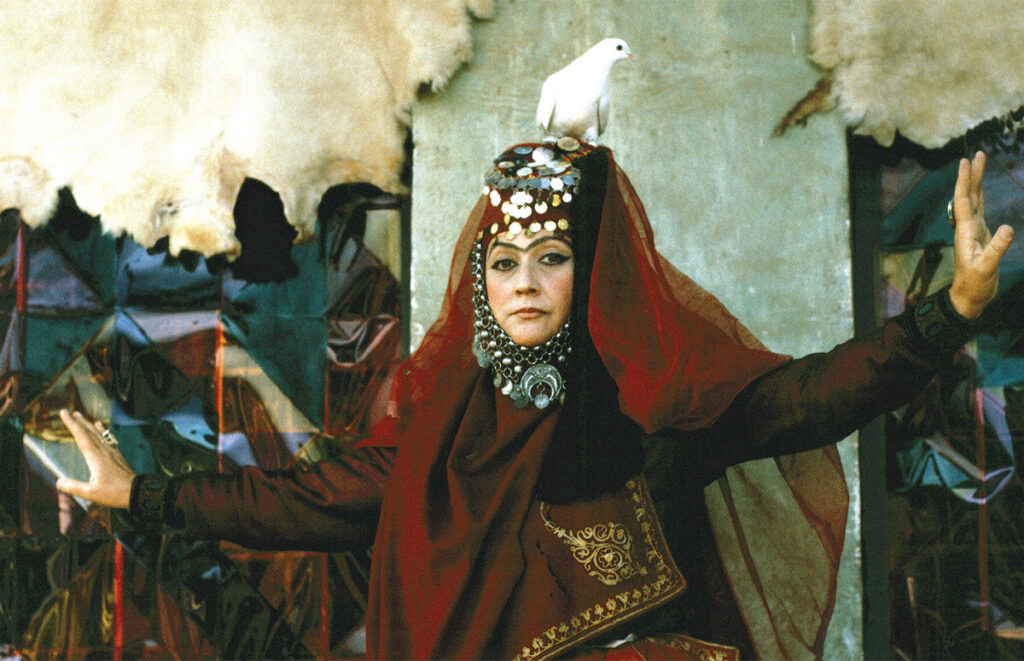[ad_1]
January marked the centennial of the birth of Soviet filmmaker Sergei Parajanov, and cinema institutions around the world have spent the year honoring him. Retrospectives of his work, including new restorations of his films, have played everywhere from Arsenal in Berlin; Il Cinema Ritrovato, the famed festival of preservation in Bologna, Italy; and the Museum of the Moving Image in New York. Armenia released new postage stamps featuring Parajanov to commemorate the occasion.
The tributes continue even with the end of the year in sight, with more screening series at the Berkeley Art Museum and Pacific Film Archive (through November 22), Anthology Film Archives in New York (November 8–17), and the University of California Los Angeles and the American Cinematheque (November 23–December 18). The long highly respected but relatively obscure director frustrated by state interference, censorship, and repression throughout his lifetime finally gets the surge of appreciation befitting his stature.
Parajanov was born to ethnic Armenians, raised in Georgia, and made films in Ukraine during the early part of his career; toward the end of his life, he would say he had “three motherlands.” Each of his films is heavily steeped in the cultures of the respective Soviet republics in which they were made. He is primarily known for his last four features, made after Andrey Tarkovsky’s Ivan’s Childhood (1962) inspired him to break from socialist realism: the Ukraine-set Shadows of Forgotten Ancestors (1965), the Armenian The Color of Pomegranates (1969), the Georgian The Legend of Suram Fortress (1985), and the Azerbaijan-set Ashik Kerib (1988). Note the 16-year interim between the second and third films: During that period, he sustained surveillance and was imprisoned multiple times on the pretext of his bisexuality and association with Ukrainian nationalist activities. He was only able to return to filmmaking amid the Soviet policy of perestroika for a few years, before dying of lung cancer in 1990.

Parajanov’s late quartet of features, as well as the shorts he directed during this time, are a rich blend of allusive, illusive, and elusive. Each adapts a folktale, short story, or novel, or pays tribute to a historical figure — but never in a straightforward way. His masterpiece The Color of Pomegranates relates the life of the famed Armenian poet and bard Sayat-Nova, but in the form of a series of enigmatic, heavily symbolic series of tableaus rather than as a traditional biopic. If you aren’t familiar with Sayat-Nova, the movie is almost impenetrable. But this doesn’t matter; every individual image in the film is striking in its composition and color. In imagining the life of a poet, Parajanov imbues the film itself with a poetic quality, organizing scenes like stanzas and shots like verses, inviting the viewer to draw their own interpretation.
Though Parajanov himself expressed disdain for his pre-Ancestors work, there has been a push in recent years to reevaluate them and broaden appreciation of his oeuvre beyond his better-known period. Ukraine’s Dovzhenko Centre and Poland’s Fixafilm have collaborated to create 4K editions of these documentaries and fiction features to join the other Parajanov restorations over the past decade, and they will be part of both the Anthology and UCLA retrospectives. For the first time, the complete filmography of one of the greatest assemblers of multilayered imagery in cinema’s history will now be accessible to general audiences.


Films directed by Sergei Parajanov are screening at BAMPFA in Berkeley (now through November 22), Anthology Film Archives in New York (November 8–17), and University of California Los Angeles and the American Cinematheque in Los Angeles (November 23–December 18).
[ad_2]
Source link

